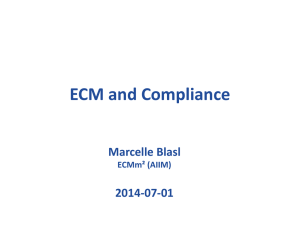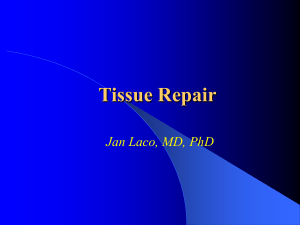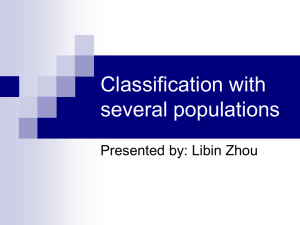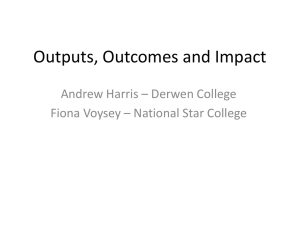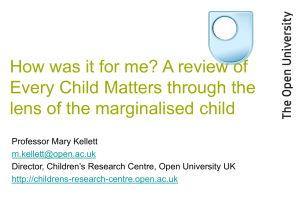Extracellular Matrix
advertisement
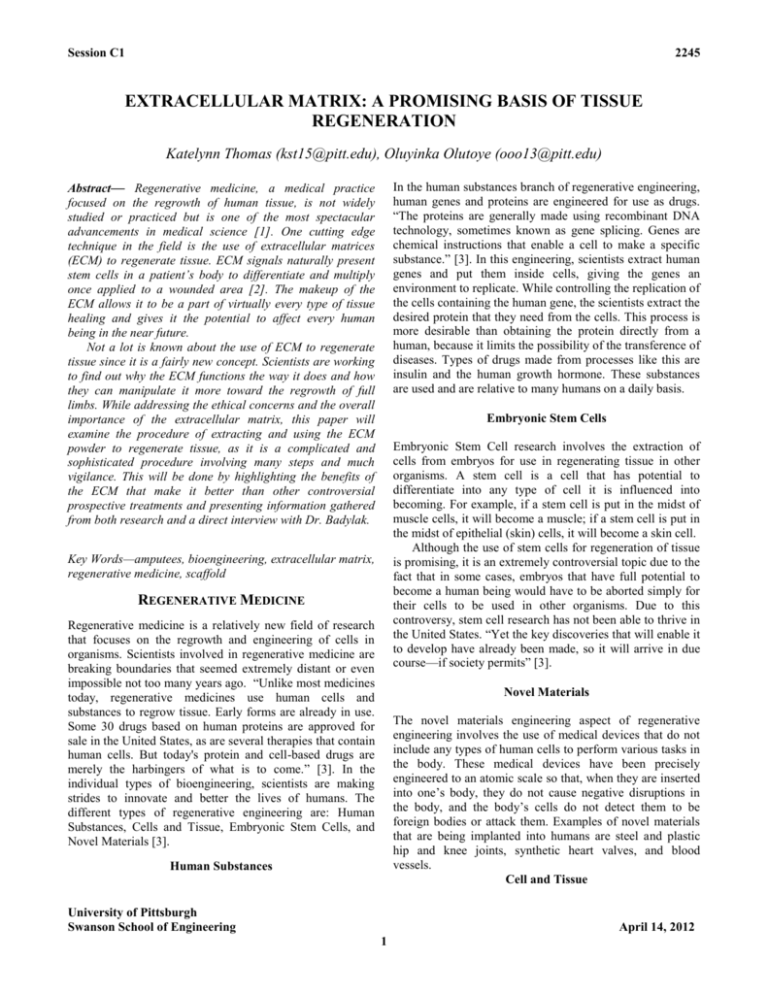
Session C1
2245
EXTRACELLULAR MATRIX: A PROMISING BASIS OF TISSUE
REGENERATION
Katelynn Thomas (kst15@pitt.edu), Oluyinka Olutoye (ooo13@pitt.edu)
Abstract— Regenerative medicine, a medical practice
focused on the regrowth of human tissue, is not widely
studied or practiced but is one of the most spectacular
advancements in medical science [1]. One cutting edge
technique in the field is the use of extracellular matrices
(ECM) to regenerate tissue. ECM signals naturally present
stem cells in a patient’s body to differentiate and multiply
once applied to a wounded area [2]. The makeup of the
ECM allows it to be a part of virtually every type of tissue
healing and gives it the potential to affect every human
being in the near future.
Not a lot is known about the use of ECM to regenerate
tissue since it is a fairly new concept. Scientists are working
to find out why the ECM functions the way it does and how
they can manipulate it more toward the regrowth of full
limbs. While addressing the ethical concerns and the overall
importance of the extracellular matrix, this paper will
examine the procedure of extracting and using the ECM
powder to regenerate tissue, as it is a complicated and
sophisticated procedure involving many steps and much
vigilance. This will be done by highlighting the benefits of
the ECM that make it better than other controversial
prospective treatments and presenting information gathered
from both research and a direct interview with Dr. Badylak.
In the human substances branch of regenerative engineering,
human genes and proteins are engineered for use as drugs.
“The proteins are generally made using recombinant DNA
technology, sometimes known as gene splicing. Genes are
chemical instructions that enable a cell to make a specific
substance.” [3]. In this engineering, scientists extract human
genes and put them inside cells, giving the genes an
environment to replicate. While controlling the replication of
the cells containing the human gene, the scientists extract the
desired protein that they need from the cells. This process is
more desirable than obtaining the protein directly from a
human, because it limits the possibility of the transference of
diseases. Types of drugs made from processes like this are
insulin and the human growth hormone. These substances
are used and are relative to many humans on a daily basis.
Embryonic Stem Cells
Embryonic Stem Cell research involves the extraction of
cells from embryos for use in regenerating tissue in other
organisms. A stem cell is a cell that has potential to
differentiate into any type of cell it is influenced into
becoming. For example, if a stem cell is put in the midst of
muscle cells, it will become a muscle; if a stem cell is put in
the midst of epithelial (skin) cells, it will become a skin cell.
Although the use of stem cells for regeneration of tissue
is promising, it is an extremely controversial topic due to the
fact that in some cases, embryos that have full potential to
become a human being would have to be aborted simply for
their cells to be used in other organisms. Due to this
controversy, stem cell research has not been able to thrive in
the United States. “Yet the key discoveries that will enable it
to develop have already been made, so it will arrive in due
course—if society permits” [3].
Key Words—amputees, bioengineering, extracellular matrix,
regenerative medicine, scaffold
REGENERATIVE MEDICINE
Regenerative medicine is a relatively new field of research
that focuses on the regrowth and engineering of cells in
organisms. Scientists involved in regenerative medicine are
breaking boundaries that seemed extremely distant or even
impossible not too many years ago. “Unlike most medicines
today, regenerative medicines use human cells and
substances to regrow tissue. Early forms are already in use.
Some 30 drugs based on human proteins are approved for
sale in the United States, as are several therapies that contain
human cells. But today's protein and cell-based drugs are
merely the harbingers of what is to come.” [3]. In the
individual types of bioengineering, scientists are making
strides to innovate and better the lives of humans. The
different types of regenerative engineering are: Human
Substances, Cells and Tissue, Embryonic Stem Cells, and
Novel Materials [3].
Novel Materials
The novel materials engineering aspect of regenerative
engineering involves the use of medical devices that do not
include any types of human cells to perform various tasks in
the body. These medical devices have been precisely
engineered to an atomic scale so that, when they are inserted
into one’s body, they do not cause negative disruptions in
the body, and the body’s cells do not detect them to be
foreign bodies or attack them. Examples of novel materials
that are being implanted into humans are steel and plastic
hip and knee joints, synthetic heart valves, and blood
vessels.
Cell and Tissue
Human Substances
University of Pittsburgh
Swanson School of Engineering
April 14, 2012
1
Katelynn Thomas
Oluyinka Olutoye
Cell and Tissue Engineering evolved from reconstructive
surgery, the rebuilding of damaged body parts. As we
become comfortable using human substances as medicines,
we are also starting to use human cells as medicine. In type 2
regenerative medicine, cells will be removed from the body,
grown in culture, then reintroduced into patients.” [3].
Tissue engineering takes two forms. One involves building
an organ or tissue outside the body by combining human
cells with appropriate materials, often a scaffold- like
structure to provide support. The other involves growing
suitable cells in laboratory flasks, then injecting them into a
tissue needing repair. The cells can often find their own way
to the sites where they are needed. This type of regenerative
engineering has been the most successful thus far, after the
human substance branch of tissue engineering. Examples of
how tissue engineering is used are in the use of artificial skin
for burn victims and the use of scaffolds as a structure on
which one can grow cells. The extracellular matrix is a
major component of these decellularized scaffolds that are
used in the regeneration.
Hyaluronic acid also plays an important role in the
function of ECM. It absorbs water and gives cells the ability
to resist compression by its swelling force. It is abundant in
the ECM around cells that bear a lot of wait, for example,
cartilage in the knees and ankles. Hyaluronic acid also plays
a role as an environmental trigger by interacting with a
receptor on cell membranes called CD44 that signals for
cells to migrate.
Collagen, Elastin, Fibronectin, and Lamnin are the
different types of fiber found in extracellular matrix.
Collagen is the most abundant protein in the ECM and gives
structure to resident cells while elastin gives tissues the
elasticity they need to perform their physiological functions.
For example, lungs need to expands and skin needs to be
able to stretch. Fibronectin allows cells to move and draw
collagen to the cells surface while lamnin gives ECM the
glue- like aspect it needs to help cells adhere to each other.
Dr. Badylak, a bioengineer at the McGowan institute for
tissue regeneration, has used extracellular matrices to
regenerate tissue. To do this, he uses ECM’s ability to use
stem cells from the organism’s own body. Dr. Badylak
extracts extracellular matrices from organisms and turns
them into a powder that he places on wounded sites where
stem cells are needed to come and differentiate into the
tissue what was present prior to the wound.
EXTRACELLULAR MATRIX
The extracellular matrix is the substance necessary for cell
growth in an organism. Rich with a variety of components,
ECM has many niches such as serving as a support structure
for cells, separating different types of tissue and facilitating
cell to cell communication during wound healing. The
matrix often acts as glue between clusters of cells. The
extracellular matrix is mostly made up of macromolecules
that are produced by the cells that are located within the
matrix. As we will discuss later on, these cells also help to
organize the matrix. The orientation of the cytoskeleton
inside the cell can control the orientation of the matrix
produced outside. Around most connective tissues, fibroblast
cells secrete macromolecules present in the matrix, however
in certain specialized types of connective tissues, such as
cartilage and bone they are secreted by chondroblasts and
osteoblasts respectively [4].
Proteoglycans are one of the many components of the
extracellular matrix. Proteoglycans are a result of
glycosaminoglycan carbohydrates that attach to extracellular
matrix proteins. The negatively charged proteoglycans
attract sodium ions that, in turn, attract water that has the
ability to trap cellular growth factors. Therefore,
proteoglycans are the component of ECM that contains
cellular growth factors, which are major factors in the cell
nutrition that is necessary for regeneration.
The different types of proteoglycans in ECM are Heparin
Sulfates, Chondroitin Sulfates and Keratin Sulfates. The
Heparin Sulfates are involved in blood coagulation and
angiogenesis (growth of new blood vessels in place of
previous blood vessels), and Chondroitin Sulfates are the
proteoglycans that supply tensile strength to cartilage,
allowing ECM to be a major source of cell support.
Decellularization and Preparation
Decellularization of an organ or tissue is the removal of all
cells and cellular contents from the sample leaving behind
extracellular matrices as a scaffold on which new cells can
be grown. “Preservation of the complex composition and
three-dimensional ultrastructure of the ECM is highly
desirable but it is recognized that all methods of
decellularization result in disruption of the architecture and
potential loss of surface structure and composition. Physical
methods and chemical and biologic agents are used in
combination to lyse cells, followed by rinsing to remove cell
remnants. Effective decellularization methodology is
dictated by factors such as tissue density and organization,
geometric and biologic properties desired for the end
product, and the targeted clinical application. [5]” There are
varieties of decellularization methods varying on the type of
tissue or organ sample being decellularized or the desired
use of the decellularized sample.
“The most effective agents for decellularization of each
tissue and organ will depend upon many factors, including
the tissue’s cellularity (e.g. liver vs. tendon), density (e.g.
dermis vs. adipose tissue), lipid content (e.g. brain vs.
urinary bladder), and thickness (e.g. dermis vs.
pericardium)” [5]. Whenever samples are decellularized
ECM composition is altered and the structure disruption, so
when decellularizing, one is to chose a method that ill
minimize these negative effects.
Tissue can be sterilized by use of chemicals, biological
substances, or physical techniques. Some chemicals used to
2
Katelynn Thomas
Oluyinka Olutoye
decellularize samples are acids, bases, detergents and
alcohols. Acids and bases break down nucleic acids while
detergents dissociate DNA from proteins and alcohols are
used to lyse (burst) cells.
Nuclease, Collagenase and Trypsin are three types of
enzymes used to decellularize biologically. Nucleases cleave
nucleic acids that are left over after cells have lysed. Trypsin
is sometimes used to decellularize, but is not used often for
it is extremely disruptive to ECM structure, because it
breaks down the ECM that is trying to be isolated as well as
the unwanted substances. Collagenase is used only when one
does not mind losing a lot of the ECM along with the
unwanted substances, because like trypsin, it breaks down
more than we would like it to.
Physical techniques used to decellularize cells are used
more often with full organs such as urinary bladders, small
intestines and skin. These techniques involve extreme
temperatures (freezing) and scraping to remove cells.
“Freeze-thaw processing effectively lyses cells within
tissues and organs, but the resulting membranous and
intracellular contents remain unless removed by subsequent
processing. A single freeze-thaw cycle can reduce adverse
immune responses such as leukocyte infiltration in vascular
ECM scaffolds. Multiple freeze-thaw cycles may be used
during decellularization and do not significantly increase the
loss of ECM proteins from tissue [5].” Scraping is also an
effective technique for tissue decellularization when
accompanied with the use of enzymes, hypertonic saline, or
chelating agents that all help remove cells from their
membranes. The use of hydrostatic pressure is one of the
most effective techniques of tissue decellularization for it
does not take much time and is more successful than
techniques involving enzymes and detergents. The only con
to the use of hydrostatic pressure is degradation of the ECM
by ice crystals that form, but this degradation can be
prevented by increasing the temperature of the fluid that is
applying pressure on the tissue.
After cells are decellularized, it is important for them to
be sterilized in cases where the scaffold left over will be
implanted into an organism simply for prevention of disease
transmission. Popular techniques for sterilization are the use
of gamma rays, electron beam irradiation and ethylene oxide
exposure, but these are known to cause disruptions in the
ECM structure which is not favorable. “Supercritical carbon
dioxide has recently been investigated as an alternative
method for sterilizing ECM, with multi-log reductions in
bacterial and viral loads within porcine dermal ECM
accompanied by minor changes in mechanical properties
relative to other sterilization methods” [5]. Decellularization
is exceedingly important in the process of preparing ECM to
be used as a scaffold or transformed into a powder.
Scientists are currently liking into ways to decellularize
more efficiently and opening windows for better results in
tissue regeneration.
The way that the extracellular matrix works is not fully
understood, but researchers are working towards finding the
answers. It is known that the ECM recruits the stem cells of
the body of the patient, but it is not certain how it does this.
A study has shown that the ECM releases bioactive peptides
when it is degraded by protease to recruit cells known as
progenitor cells [6]. The structural support of the ECM is
what aids in the growth of the cells once they are recruited.
Also, the physical and chemical conditions of the ECM
provide a preferred environment for tissue to grow [7]. This
effectively tricks the body into regenerating rather than
scarring [2].
CURRENT STUDIES
Many of the scientific studies involving the extracellular
matrix are currently being performed so the information
known is preliminary. A study by the McGowan Institute for
Regenerative Medicine and the University of Pittsburgh
Department of Surgery is focusing on the healing process of
two different strains of mice in order to determine how
regeneration is likely to occur. In this study sixty mice were
divided into fifteen groups. Each mouse underwent surgery
to amputate the third digit of their right rear paw at the
middle of the second phalanx. The wounds were then
allowed to heal naturally for fourteen days. Every day one
group of the mice was euthanized so that the paw could be
removed and observed. To be prepared for observation, the
paw was submerged in a buffer for forty-eight hours and
then submerged in formic acid to be decalcified. After this
process, the paw could be stained and observed [8].
The main goal of this stain was to determine the ratio of
collagen type I and III. On the first day, it was observed in
both strains of mice that a blood clot and inflammatory cell
infiltrate had formed, but a new epithelial layer had not
formed. Also, it was found that progenitor cells surrounded
the edge of the wound. After a couple days, both strains
epithelial cells that invaginations and reached the tip of the
bone that had been cut. These invaginations separated the
wound area from the normal dermis surrounding the wound.
The first noticeable dermal layer was noticed between four
and five days. After nine days, a complete epithelium was
formed. Between nine and fourteen days, the epithelium
thinned and a neodermis formed in its place. By the last day
(day fourteen), the epidermis was at its normal state [8].
At the beginning of the healing process, collagen type I
seen in normal amounts. As healing occurred, the amount of
collagen type II increased. Collagen type I did not increase
until after about day seven when the healing process had
already been occurring for a significant amount of time. This
showed a larger ratio of the two types of collagen as healing
progressed. The results of this study support the possibility
of tissue regeneration with the necessary stimulus because of
the presence of the progenitor cells. It is believed that these
cells, along with myofibroblast and vascular cells, were from
How it Works
3
Katelynn Thomas
Oluyinka Olutoye
the bone marrow of the mice [8]. The concept of cells
coming from the bone marrow of the organism is a strong
idea of the extracellular matrix. The whole purpose of the
extracellular matrix is to recruit these cells. The extracellular
matrix must be the necessary stimulus.
Another study on progenitor cells by the McGowan
Institute for Regenerative Medicine was conducted in the
same manner. The difference in this study was that some of
the mice were treated with a peptide (a group of amino
acids). The mice that were not treated with the peptide were
the control for the experiment. The mice that were treated
with the peptide showed regeneration of the digit, but the
control mice showed normal healing and scarring [6]. The
ECM contains peptides so the peptides may prove to be a
link between the normal healing observed in the first
experiment and the regeneration caused by the extracellular
matrix.
These studies give scientific support to the theories
behind the extracellular matrix. However, it does not show
the possibilities or the successes of the ECM. The ECM has
already been used in a number of cases to regenerate the
tissues of wounds and amputated digits.
large and piece of the bone was missing. The horse had gone
through many surgeries in which the ECM powder was put
into the wound, and within a year, the horse’s face had
completely healed [2].
The potential of the extracellular matrix was also seen
when a woman from California had lost the tip of her finger.
Just as in the case of the hobby shop owner, doctors had told
the woman that her finger would have to be amputated
further. The woman researched to find a different way to
heal her finger. She contacted Dr. Badylak and was told by
his associates that they would look into her case but they did
not know of any doctors that practiced regenerative
medicine in her area. Since regenerative medicine is a
relatively new field, not many doctors know about it or are
comfortable using it. The woman gave Dr. Michael Peterson
of Davis information on the topic and he agreed to try it. Dr.
Peterson applied MatriStem wound powder to the woman’s
finger after debridement (cleaning and removing scar tissue).
Within a few weeks, her fingertip had regenerated. The
finger is slightly shorter than it originally was, but it still
functions and looks like an average finger [9].
As indicated earlier, these cases cannot be considered as
scientific data due to the circumstances, but they are still
extraordinary examples of what the extracellular matrix is
able to accomplish [2]. No complicated procedure was
necessary to help these people. Simply applying the powder
containing the extracellular matrix was enough to regenerate
a whole fingertip. It is obvious that this miracle powder has
the potential to change the lives of every human being. In
the future if this advancement can be used to regenerate full
limbs, the ECM will help many injured people to live normal
lives. No more would soldiers be forced to handle the burden
of missing a limb after fighting for their country or would
victims of unfortunate events be forced to depend on the
people around them. Amputated limbs could regenerate as if
an accident had never occurred.
FINGER REGENERATION
The extracellular matrix has proven to be affective in a
few cases; however, most of these cases cannot be
considered true scientific studies. There has been success in
many situations from regenerating cartilage after sports
injuries, rebuilding urethras, and repairing hernias. Two
specific scenarios in which the ECM helped to regenerate
the tissues of two people’s fingers did not take place in
monitored or controlled settings. Therefore, the results can
only be used as indications of what the ECM has the
potential to do [2].
The extracellular matrix showed its potential after a
hobby shop owner had lost the tip of his finger while testing
the metal propellers of a model helicopter. Doctors had told
the man that not only were they unable to save his finger, but
also they would need to amputate it further because of
infection. The man contacted another doctor that he knew,
Dr. Alan Spievack, and Dr. Spievack sent him a vial of ECM
powder. The man put a small amount of the powder onto the
wound every other day for eight days, and within a few
weeks the tip of the finger had grown back. The regenerated
tip looks and functions just as the original tip had. Besides
the slightly tougher skin, the only difference in the
regenerated tip is the fingernail. The fingernail grows much
faster than the rest of his fingernails, but everything else,
including the finger print, is the same as it was before the
accident [2].
Dr. Spievack was aware of this treatment because his
company, ACell, had used the ECM powder to treat injured
animals. One of these cases was that of a horse who had
gauged a hole into his face on a fence. The wound was a
ETHICS AND SUSTAINABILITY
Much controversy has surrounded the current practices of
tissue regeneration such as the use of embryonic stem cells.
The extracellular matrix provides a more ethical alternative
to such treatments. The use of one’s own stem cells is
beneficial when considering the ethics of the treatment.
While embryonic stem cells are taken from the embryo of
the unborn, the extracellular matrix calls upon the stem cells
that exist naturally in the bone marrow of the patient being
treated. The extracellular matrix is usually taken from the
bladder of a pig, but any ethical issues that are caused by this
will be small in comparison to the ethical issues of using the
stem cells of an embryo. Animal rights activists may have
issues with this sort of practice, but the majority of the
public should not mind. It is common practice to use pigs for
food and medicine. Pigs have been used for their heart
valves and for medical tests for several years because of
their genetic similarity to humans.
4
Katelynn Thomas
Oluyinka Olutoye
A more serious ethical issue would arise if knowledge of
the ECM was not pursued. Now that we know what potential
the ECM holds for helping the world, it would be unethical
to not do anything in our ability to use it. According to the
biomedical engineering society (BMES), biomedical
engineering researchers have the ethical responsibility to
help injured people. The BMES code of ethics states that
“Biomedical engineers in the fulfillment of their professional
engineering duties shall: Use their knowledge, skills, and
abilities to enhance the safety, health, and welfare of the
public,” [10]. By this code, bioengineers are ethically bound
to search for ways such as this to help the world.
Engineers today are not just concerned with ethics. They
are also concerned with the issue of sustainability. The ECM
can be considered more sustainable than prosthetics.
Prosthetics usually consist of manmade materials. Manmade
materials can be durable and affective but they are not as
sustainable as a patient’s own flesh and bone. The manmade
materials are occasionally produced in a manner that is
harmful to the environment, and even if they are not
produced in such a way, they are usually not biodegradable.
When a human passes on, their body decomposes so a
regenerated limb would decompose with the body leaving no
extra waste.
ECM encourages cells to regrow tissue rather than growing
scar tissue so it could have potential to heal skin rather than
scar after a surgery.
REFERENCES
[1] G. Steinhoff. (2010, April). Regenerative Medicine. [Online Book].
Available:
https://sremote.pitt.edu/content/w1m086/,DanaInfo=www.springerlink.com
+#section=854441&page=1
[2] M. Rosenwald. (2007, September 18). “A Doctor, a Pig, and a Magical
Pixie Dust That Could Regrow Fingers.” Esquire. [Online]. Available:
http://www.esquire.com/features/esquire-100/pigfinger1007-3
[3] W. Haseltine. (2003),. “Regenerative Medicine: A Future Healing Art”.
Brookings
[Online
Article],
Available:
http://www.brookings.edu/articles/2003/winter_healthcare_haseltine.aspx
[4] B. Alan. (2002).”The Extracellular Matrix of Animals.” Molecular
Biology
of
the
Cell.
[Online
Book]
Available:
http://www.ncbi.nlm.nih.gov/books/NBK26810/
[5] P. Carapo. (2011)” An overview of tissue and whole organ
decellularization
processes”.
[Online].
Avaiable:
http://www.sciencedirect.com/science/article/pii/S0142961211000895
[6] V. Agrawal, S. Tottey, S. Johnson, J. Freund, B. Siu, and S. Badylak.
(2011, October 17). “Recruitment of Progenitor Cells by an Extracellular
Matrix Cryptic Peptide in a Mouse Model of Digit Amputation.” Tissie
Engineering
Part
A.
[Online].
Available:
http://online.liebertpub.com/doi/full/10.1089/ten.tea.2011.0036
[7] A. Bella. “Extracellular Matrix Could Lead to Advances in Regenerative
Medicine.” (2011, December 20). Science Daily. [Online]. Available:
http://www.sciencedaily.com/releases/2011/12/111220102532.htm.
[8] N.Turmer. (2010). “A histomorphologic study of the normal healing
response following digit amputation in C57bl/6 and MRL/MPJ mice*”
{Online}.
Available:
POTENTIAL AND POSSIBILITIES
It has already been demonstrated that the extracellular
matrix has great potential to help the world. This potential is
what gives the ECM relevance to society. Society needs this
medical advancement. Currently the ECM is being used to
regenerate tissues after there has been significant damage
done to a body part. Whether the damage is from a burn or
amputating a fingertip, the ECM has been successful in
healing the wound and returning it to its normal state. The
ECM was even successful in restoring a soldier’s thigh after
the majority of it had been lost from an injury in combat.
There is still much to learn about the ECM. Researchers
are searching for the answer of why and how the ECM does
what it does and how they can manipulate it to do what they
want it to do. Since potential to regrow full limbs has been
shown, researchers are investigating what must be added to
the ECM in order to fulfill that potential. It is the hope of
researchers that in the near future people will not have to
suffer from the loss of a limb because they will be able to
regenerate a fully functional new limb.
In the future, the ECM may be able to help in surgical
practices. One of these practices may be replacing a
deformed limb. Removing a deformed limb is not usually a
treatment that is considered, but with the ability to regrow a
functional limb, it could become a beneficial and acceptable
practice. The ECM would enable the patient to regrow his or
her limb without the deformity and without having to live a
life with a disability. Another possibility for the use of the
ECM in surgical practices could be to prevent scarring. The
http://www.jstage.jst.go.jp/article/aohc/73/2/103/_pdf
[9] E. Cohen. (2010, September 9). “Woman’s persistence pays off in
regenerative fingertip.” CNN Health. [Online Article]. Available:
http://www.cnn.com/2010/HEALTH/09/09/pinky.regeneration.surgery/inde
x.html?iref=allsearch.
[10]“Biomedical Engineering Society Code of Ethics.” Biomedical
Engineering Society Code of Ethics. [Online Web Site] Available:
http://www.bmes.org/aws/BMES/pt/sp/ethics
ADDITIONAL REFERENCES
H. Fernandes, L. Moroni, C. van Blitterswijk, and J. de Boer. (2009, May
19). “Extracellular matrix and tissue engineering applications.” Journal of
Materials
Chemistry.
[Online].
Available:
http://pubs.rsc.org/en/content/articlehtml/2009/jm/b822177d
R. Mecham. (2011). The Extracellular Matrix: An Overview. London NY:
Springer.p.1-41
S. Badylak. (2007, May 8). “The extracellular matrix as a biologic scaffold
material.”
Elsevier.
[Online.]
Available:
http://pdn.sciencedirect.com/science?_ob=MiamiImageURL&_cid=271870
&_user=10183724&_pii=S0142961207003456&_check=y&_coverDate=20
07-09-01&view=c&wchp=dGLbVBAzSkWA&md5=9ac047cf47b5c05df01db602fa90a0c7/1-s2.0S0142961207003456-main.pdf
ACKNOWLEDGEMENTS
We would like to thank Dr. Badylak for meeting with us and
explaining his research to us. We would also like to thank
our Co-chair, Abby, for assisting us with our paper and
being a helpful advisor.
5
Katelynn Thomas
Oluyinka Olutoye
6



